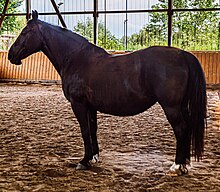
Summary
The Rottaler is a German breed of riding and carriage horse of heavy warmblood type.[4]: 499 The name derives from that of the Rottal, the valley of the Rott in the Landkreis of Rottal-Inn in south-eastern Bavaria. It is critically endangered.[2] The Bavarian Warmblood derives from it.[5]: 184
 | |
| Conservation status | |
|---|---|
| Other names |
|
| Country of origin | Germany |
| Distribution | Bavaria |
| Use | carriage horse |
| Traits | |
| Weight |
|
| Height | |
| Colour | usually bay, also black or chestnut |

History edit
The Rottaler originated in – and is named for – the Rottal, the valley of the Rott in the Landkreis of Rottal-Inn in south-eastern Bavaria, an area renowned for horse-breeding.[4]: 499
A breed society, the Rottaler Warmblutpferdezuchtverein, was formed in 1906.[6] A breed standard was drawn up, calling for a strong and capable carriage horse with lively gaits, characterised by good temperament, fertility and longevity.[6] After the end of the Second World War there seemed to be no demand for such an animal, and the breeding goal was fundamentally changed; selection was aimed exclusively at the creation of a warmblood sport horse – which would eventually become the Bavarian Warmblood. A programme of breed replacement was adopted: Rottaler mares (of which only about 250 remained) were put to Hanoverian or Westphalian stallions, while Rottaler stallions were excluded from registration. In 1963 the traditional "R" brand of the Rottaler was changed to a "B".[6]
Only a small number of Rottaler mares survived this period. A census was taken in 1991, and eleven mares were found; two part-bred stallions from Rottaler dam lines were identified. From this nucleus, conservation breeding began. A new stud-book was started in 1994.[6]
In the twenty years from 2000 to 2019, the number of recorded breeding mares varied between 14 and 29, and the number of stallions ranged from 2 to 11.[7] The Rottaler is an endangered breed, and is listed in the highest-risk category (category I: extrem gefährdet, "extremely endangered") on the Rote Liste of the Gesellschaft zur Erhaltung alter und gefährdeter Haustierrassen.[3] In 2000 it was the "endangered breed of the year" of that association.[8]
In 1966 a large bronze sculpture of the Rottaler by Hans Wimmer was erected in the Stadtplatz or main square of Pfarrkirchen.[9]: 3
References edit
- ^ Barbara Rischkowsky, Dafydd Pilling (editors) (2007). List of breeds documented in the Global Databank for Animal Genetic Resources, annex to The State of the World's Animal Genetic Resources for Food and Agriculture. Rome: Commission on Genetic Resources for Food and Agriculture, Food and Agriculture Organization of the United Nations. ISBN 9789251057629. Archived 23 June 2020.
- ^ a b c d e Breed data sheet: Engadiner Schaf / Switzerland (Sheep). Domestic Animal Diversity Information System of the Food and Agriculture Organization of the United Nations. Accessed July 2021.
- ^ a b Rottaler Pferd (in German). Gesellschaft zur Erhaltung alter und gefährdeter Haustierrassen. Archived 27 January 2021.
- ^ a b Valerie Porter, Lawrence Alderson, Stephen J.G. Hall, D. Phillip Sponenberg (2016). Mason's World Encyclopedia of Livestock Breeds and Breeding (sixth edition). Wallingford: CABI. ISBN 9781780647944.
- ^ Élise Rousseau, Yann Le Bris, Teresa Lavender Fagan (2017). Horses of the World. Princeton: Princeton University Press. ISBN 9780691167206.
- ^ a b c d Arno Scherling (1995). Rottaler Pferd (in German). Gesellschaft zur Erhaltung alter und gefährdeter Haustierrassen. Archived 28 September 2010.
- ^ Pferd: Rottaler (in German). Zentrale Dokumentation Tiergenetischer Ressourcen in Deutschland. Accessed July 2021.
- ^ Gefährdete Nutztierrasse des Jahres (2000 bis 2002) (in German). Gesellschaft zur Erhaltung alter und gefährdeter Haustierrassen. Archived 23 November 2016.
- ^ Regierungsbezirk Niederbayern, Landkreis Rottal-Inn, Stadt Pfarrkirchen: Baudenkmäler (in German). Bayerisches Landesamt für Denkmalpflege. Accessed July 2021.


